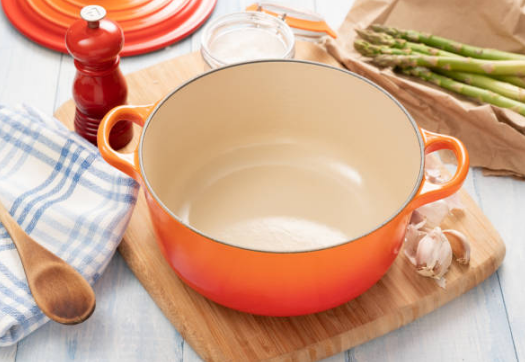Want to know “What is a Dutch roast pot for?” “Stew, roast, stew, simmer, serve, etc. This Ina Garten staple and generational cooking and baking BFF is a must-have cooking appliance for many homes in the United States and around the globe.
There’s no denying that a Dutch roast can take a significant investment, depending on its features and the brand you’re buying. However, it can last a lifetime (as long as you follow our guidance to clean the Dutch roast pan and keep it in tip-top condition). In addition, during use, Dutch roasts can accomplish a wide variety of cooking tasks.

Next, we will answer the question “What exactly is a Dutch roast?” Learn about the history of this versatile culinary marvel, then learn more about how to care for a Dutch roast and what to cook with a Dutch roaster.
What Is a Dutch Oven?
Legend has it that during a trip to the Netherlands, an Englishman noticed a shallow round pot made from molten iron molds made of sand. Therefore, he considered it “Dutch” as a tribute to the people who made these pots at the time.
The Dutch pot is essentially a shorter, heavier stockpot that is also double-handled, but with cast iron instead of stainless steel or other metals, and its design is top-notch when it comes to heat preservation. A tightly filled lid, a thick base, and sturdy walls help keep the internal temperature fairly stable throughout the cooking process. This even heat can be dissipated through the pan, allowing the food inside the pan to cook evenly, whether you’re using a Dutch pot on the stove or in the oven.
Modern Dutch griddles come in a variety of sizes and styles, and almost all of them are aesthetically pleasing enough to double as a serving vessel. You may have heard of (or may already own) one of the most popular Dutch roast pot brands, such as Le Creuset, Staub, Great Jones, Our Place, Caraway, Lodge, or Cuisinart.
What Is a Dutch Oven Used For?
Now you know the question “What is a Dutch Grill?” It’s time to dive into how to get the most out of this versatile pot. As we mentioned, you can cook or bake in a Dutch roast on the stove or in the oven. Its thick-walled, insulated lid, and large size make it an ideal tool for frying, stewing, roasting, brising, roasting, sautéing, serving, and more.

How to Choose the Right Size Dutch Grill for Your Needs?
Dutch ovens are usually made from one of three materials.
- Bare Cast Iron: Just like a cast iron skillet, a cast iron Dutch roast requires TLC and a special cleaning strategy to maintain its seasoning layer and non-stick.
- Enamelled cast iron pots: maybe you’ve heard, seen, or used Le Creuset for cooking? This is an example of this Dutch oven series, which is coated with an enamel layer and is easier to care for than a bare cast iron pan. These models are durable, versatile, and stylish enough to be used as cutlery. They’re certainly more expensive than bare cast iron pans, though – and can almost always stand the test of time if properly cared for.
- Ceramic: The lightest of all Dutch ovens, it has the same benefits of being easy to clean and durable as an enamel-coated Dutch oven, but is more prone to cracking when dropped or subjected to extreme heat or cold.
In terms of size and shape, there is no one Dutch roast pan that fits every kitchen. When you’re considering investing in a new Dutch Grill, think about how you plan to use the Dutch Grill most often and where you’ll store it. Ask yourself:
- How many people do you plan to serve with a Dutch roaster?
- Will you use it more for baking or cooking?
- Do you have cupboard space to store your Dutch griddle? If not, what shape, size, and color would be best for your stovetop?
A 5 ½-quart size is the “standard” size, but Dutch griddles can range in capacity from 1 quart (for up to one diner or a couple) to 13 1/4 quarts (for more than 9 people).
How to Care for a Dutch Griddle?
If you choose a bare pan, follow our cast iron care tips to protect your pan and pan for a long time. Although most enamelled Dutch pots and some ceramic Dutch pots can be washed in the dishwasher, hand washing is recommended. Follow these tips to properly care for your Dutch pot:
- Do not expose a hot Dutch roast to cold water or extremely low temperatures; It may break.
- Use hot, soapy water and a cloth or soft sponge (not an abrasive metal brush) to clean.
- Soak 3 tablespoons of bleach per quart of water to remove adhered dirt or oily residue. After about 2 hours, the adhered dirt should wipe clean.
- Or stuck? Try boiling 1 tablespoon of baking soda in a Dutch pot filled with water for 10 minutes. Once it has cooled, rinse it with soapy water and then rinse it with clean water.
- Run a drying cycle – or in other words, store a Dutch roast only after you have thoroughly dried the inside and outside with a soft, clean cloth.
Dutch Roast Pot Substitute
Not ready to buy a Dutch roast pot, or currently don’t have the space for additional cooking equipment. A large saucepan or stockpot with a lid may be able to bend (although it may not cook evenly and gently) and can also be used in Dutch grill recipes, depending on its heat resistance. Slow cookers and instant pots can also grill and cook ingredients gently, although overall recipe cooking times will vary greatly.
